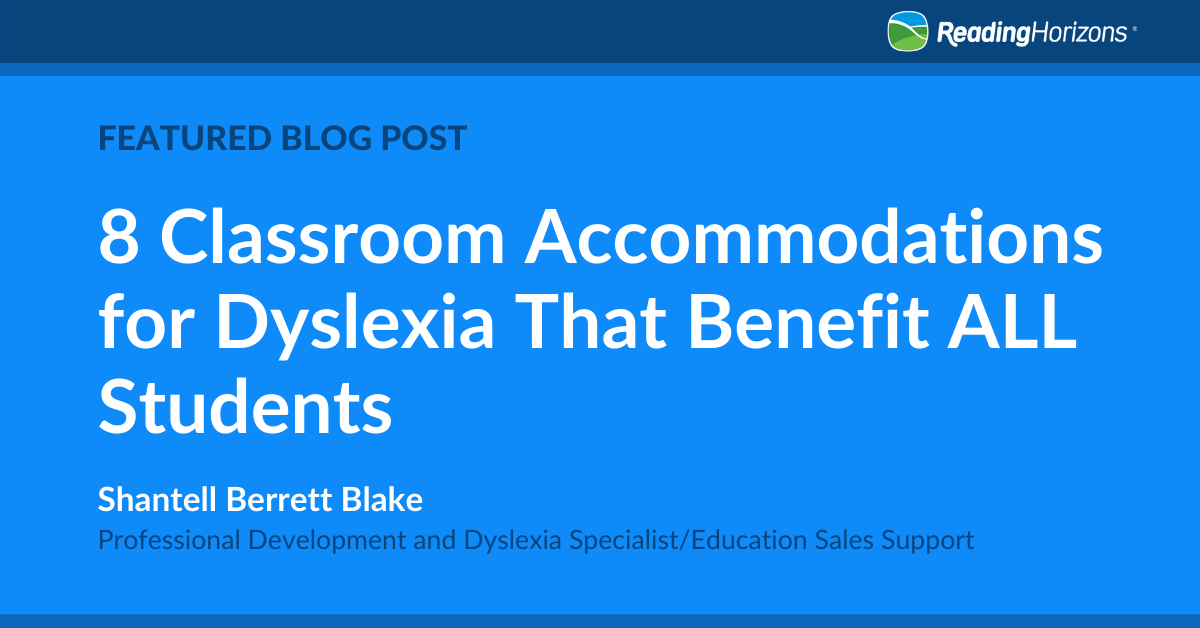Our dyslexia specialist and Director of Professional Services, Shantell Berrett Blake, has a favorite saying she always tells teachers when preparing them to help struggling readers (including those with dyslexia): “It is far more about the process than the content.”
Students with dyslexia have a dominant right brain that offers them many unique strengths. However, tasks, including language tasks like reading, that require a set process to accomplish (and a stronger left brain) are much more difficult for them. Despite the obstacle this struggle presents, it provides valuable insights into how to improve teaching processes. Students with dyslexia require a clear process to understand many concepts (especially how to read), but clear, explicit phonics instruction is beneficial for every student.
Learn how you can better support students with dyslexia through our free eBook that has practical strategies and tools!
Here are eight tips from Shantell that you can implement to accommodate the needs of every learner in your classroom (especially the ones with dyslexia!).
Eight Accommodations for Dyslexia
1. Provide one-step directions at a time.
How it helps students with dyslexia
Because dyslexia is a processing disorder, students with dyslexia have difficulty processing, prioritizing, and remembering long lists of directions. By giving one direction at a time, students with dyslexia don’t have to juggle multiple steps at once—ensuring they can follow your instructions. Simplifying steps will decrease frustration for both you and the student.
How it helps all students
Even without dyslexia, we are all prone to distractions and forgetfulness. By only giving one direction at a time, you eliminate the possibility of students forgetting what they need to do, and you won’t have to repeat directions nearly as often.
2. Provide visual representation of all oral instruction whenever possible.
How it helps students with dyslexia
Since the brain of students with dyslexia isn’t naturally wired to engage the left side, to rewire the brain, these students need multisensory instruction that engages multiple areas of the brain. By connecting visual, auditory, and kinesthetic cues to each concept, different parts of the brain are activated—allowing students with dyslexia to make new brain connections that help them strengthen their left brain and better remember information.
How it helps all students
Again, even without dyslexia, we are all prone to forgetfulness. By connecting multiple stimuli to a concept, students better remember and absorb new information.
3. Preview and review.
How it helps students with dyslexia
By previewing each concept before instruction, students with dyslexia can better organize, filter, and prioritize new information. Reviewing each concept helps dyslexic students connect, store, and categorize information that was just presented. Both help with the executive function deficits associated with dyslexia.
How it helps all students
One of the most effective ways we learn any concept is through repetition. The more we hear and practice an idea, the more natural and easy to remember it becomes.
4. Pre-warn students when activities are about to change.
How it helps students with dyslexia
It can be difficult for some students with dyslexia to switch their attention between activities. Many students need prep time to know an activity is about to end and they will be doing something different soon. Warning students can also help them be patient when they want to move on to a new activity. Because reading tasks can strain dyslexic students, letting them know that they only have to exert themselves for five more minutes can help them keep trying. Give a time warning five minutes before an activity will change, then two minutes, then one minute (e.g., “Five more minutes of reading time. Now two until we move to centers. One more minute.”).
How it helps all students
With or without dyslexia, some students can get so absorbed in an activity that when the class suddenly changes pace, they can easily get upset. By helping all students prepare for what is coming, you can avoid upsetting and frustrating students—reducing conflict and creating a better classroom environment for everyone.
5. Avoid habituation* by keeping instruction between 10–15 minutes and providing a variety of activities for practice.
How it helps students with dyslexia
“Due to the problems in inhibition (focus on relevant, suppress the irrelevant), switching attention, and working memory (sustaining effort for coordinating orthography and phonology over time), students with dyslexia and/or dysgraphia are likely to habituate (stop responding to instruction) sooner than children without these disorders. One way to avoid habituation is to vary activities frequently and avoid performing the same activity over and over for a long time.” (Berninger and Wolf. Teaching Students with Dyslexia and Dysgraphia. Paul H. Brookes Publishing Co., Inc. 2009. P. 146.)
How it helps all students
Like the above quote says, habituation occurs sooner for students with dyslexia. But with enough exposure to a certain stimulus, all students habituate. By keeping instruction novel, you better keep the attention of all of your students so they stay engaged and focused on instruction.
*Habituation refers specifically to a type of non-associative learning in which repeated exposure to a stimulus leads to a decreased response.
6. Never expect students with dyslexia to take notes without a visual outline or a friend to be a note-taker.
How it helps students with dyslexia
Writing tasks are typically very difficult for students with dyslexia. On top of their difficulties with prioritizing information, note-taking can be extremely difficult for these students. By providing an outline or assigning them a friend that they can compare notes with, you can help eliminate stress during lectures.
How it helps all students
Deciding what is important to note during instruction is difficult for many students—having a partner for each student to talk over a lecture with and decide what was important or see if they missed an important point is beneficial for every student.
7. Slow down instruction.
How it helps students with dyslexia
Students with dyslexia need additional time to process information. Take your time, and be clear. Assess in small intervals if the students are getting what you are modeling/teaching. (Ask them questions and provide opportunities to have them tell you in their own words what you just told them).
How it helps all students
Taking time to ensure student understanding and matching pacing to the needs of your classroom is helpful for every student. Undoubtedly, you will have students at varying levels, but as you assess students in small intervals, you can use learning centers that allow students of varying levels to work at their own pace. Also, patience and empathy are arguably more valuable than lesson content.
8. Assume nothing—connect everything.
How it helps students with dyslexia
To adjust to the needs of students with dyslexia, it is helpful to teach one concept at a time while you draw connections to prior knowledge and previous instruction with ALL new material. This helps these students make new neural connections that will strengthen their brain.
How it helps all students
Some students naturally connect new information to what they already know, but many students need to be taught how to connect everything. Even some of your brightest students won’t always draw connections between new information.

